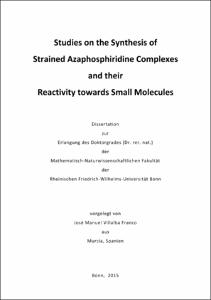Villalba Franco, José Manuel: Studies on the Synthesis of Strained Azaphosphiridine Complexes and their Reactivity towards Small Molecules. - Bonn, 2015. - Dissertation, Rheinische Friedrich-Wilhelms-Universität Bonn.
Online-Ausgabe in bonndoc: https://nbn-resolving.org/urn:nbn:de:hbz:5n-42364
Online-Ausgabe in bonndoc: https://nbn-resolving.org/urn:nbn:de:hbz:5n-42364
@phdthesis{handle:20.500.11811/6590,
urn: https://nbn-resolving.org/urn:nbn:de:hbz:5n-42364,
author = {{José Manuel Villalba Franco}},
title = {Studies on the Synthesis of Strained Azaphosphiridine Complexes and their Reactivity towards Small Molecules},
school = {Rheinische Friedrich-Wilhelms-Universität Bonn},
year = 2015,
month = dec,
note = {The objective of this PhD Thesis was to build up a three-membered ring system containing phosphorus, carbon and nitrogen atoms, namely azaphosphiridines, which would exhibit higher reactivity than those azaphosphiridine systems reported before, and to study its ability to react with various, rather unreactive small molecules. This objective was approached from two different angles: i) the employment of a phosphorus bound pentamethyl cyclopentadienyl (Cp*) group and ii) the presence of an exocyclic imino bond at the ring carbon atom. Synthesis of a P-Cp* substituted azaphosphiridine complexes were attempted first by reaction of P-Cp* substituted Li/Cl phosphinidenoid complex with a series of carbaldimines. Reaction with furan-2-carbaldimine yielded selectively a novel complex having a N,P,C-cage type ligand. The presence of the expected azaphosphiridine complex and an amino-phosphinidene complex, which is stabilized by non-covalent interactions, as intermediates, is supported by low temperature 31P NMR monitoring as well as DFT calculations and trapping reactions. Reaction of thermally generated P-Cp* substituted transient terminal electrophilic phosphinidene complex with the same set of carbaldimines yielded a mixture of two kind of N,P,C-cage complexes that were found to be in equilibrium through an amino-phosphinidene complex which was trapped by phenylacetylene and phenylcarbaldimine. The synthesis of the highly strained 3-iminoazaphosphiridine complexes was achieved by reaction of Li/Cl phosphinidenoid complexes and carbodiimides. This new kind of species, which is in equilibrium with an end-on carbodiimide-to-phosphinidene complex adduct, were found to react towards small molecules via three different pathways which were studied computationally. Reactions with carbon dioxide, phenylisocyanate, pentafluorobenzaldehyde, and water proceed via initial van der Waals interaction of the exocyclic imino nitrogen atom with the substrate. In case of the carbonylic compounds 1,3,5-oxazaphospholane complexes were formed while reaction with water led to a complex with a 1,3-zwitterionic P-ligand. In contrast, reaction with carbon monoxide, isocyanides, benzaldehyde and N,N’-dicyclohexylcarbodiimide do it by ligand displacement at phosphorus in the end-on carbodiimide-to-phosphinidene complex adduct, thus revealing the unusual coordination chemistry of a low-coordinate phosphorus centre mimicking the reactivity of transition metal complexes. Moreover, the work describes endocyclic P-C bond insertion of chalcogen atoms such as sulfur and selenium.},
url = {https://hdl.handle.net/20.500.11811/6590}
}
urn: https://nbn-resolving.org/urn:nbn:de:hbz:5n-42364,
author = {{José Manuel Villalba Franco}},
title = {Studies on the Synthesis of Strained Azaphosphiridine Complexes and their Reactivity towards Small Molecules},
school = {Rheinische Friedrich-Wilhelms-Universität Bonn},
year = 2015,
month = dec,
note = {The objective of this PhD Thesis was to build up a three-membered ring system containing phosphorus, carbon and nitrogen atoms, namely azaphosphiridines, which would exhibit higher reactivity than those azaphosphiridine systems reported before, and to study its ability to react with various, rather unreactive small molecules. This objective was approached from two different angles: i) the employment of a phosphorus bound pentamethyl cyclopentadienyl (Cp*) group and ii) the presence of an exocyclic imino bond at the ring carbon atom. Synthesis of a P-Cp* substituted azaphosphiridine complexes were attempted first by reaction of P-Cp* substituted Li/Cl phosphinidenoid complex with a series of carbaldimines. Reaction with furan-2-carbaldimine yielded selectively a novel complex having a N,P,C-cage type ligand. The presence of the expected azaphosphiridine complex and an amino-phosphinidene complex, which is stabilized by non-covalent interactions, as intermediates, is supported by low temperature 31P NMR monitoring as well as DFT calculations and trapping reactions. Reaction of thermally generated P-Cp* substituted transient terminal electrophilic phosphinidene complex with the same set of carbaldimines yielded a mixture of two kind of N,P,C-cage complexes that were found to be in equilibrium through an amino-phosphinidene complex which was trapped by phenylacetylene and phenylcarbaldimine. The synthesis of the highly strained 3-iminoazaphosphiridine complexes was achieved by reaction of Li/Cl phosphinidenoid complexes and carbodiimides. This new kind of species, which is in equilibrium with an end-on carbodiimide-to-phosphinidene complex adduct, were found to react towards small molecules via three different pathways which were studied computationally. Reactions with carbon dioxide, phenylisocyanate, pentafluorobenzaldehyde, and water proceed via initial van der Waals interaction of the exocyclic imino nitrogen atom with the substrate. In case of the carbonylic compounds 1,3,5-oxazaphospholane complexes were formed while reaction with water led to a complex with a 1,3-zwitterionic P-ligand. In contrast, reaction with carbon monoxide, isocyanides, benzaldehyde and N,N’-dicyclohexylcarbodiimide do it by ligand displacement at phosphorus in the end-on carbodiimide-to-phosphinidene complex adduct, thus revealing the unusual coordination chemistry of a low-coordinate phosphorus centre mimicking the reactivity of transition metal complexes. Moreover, the work describes endocyclic P-C bond insertion of chalcogen atoms such as sulfur and selenium.},
url = {https://hdl.handle.net/20.500.11811/6590}
}






